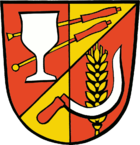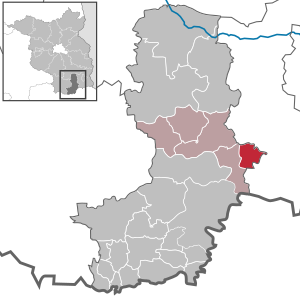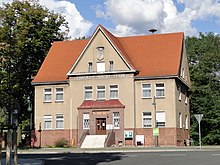Neupetershain
| coat of arms | Germany map | |
|---|---|---|

|
Coordinates: 51 ° 36 ' N , 14 ° 10' E |
|
| Basic data | ||
| State : | Brandenburg | |
| County : | Oberspreewald-Lausitz | |
| Office : | Altdöbern | |
| Height : | 124 m above sea level NHN | |
| Area : | 18.8 km 2 | |
| Residents: | 1196 (Dec. 31, 2019) | |
| Population density : | 64 inhabitants per km 2 | |
| Postal code : | 03103 | |
| Area code : | 035751 | |
| License plate : | OSL, CA, SFB | |
| Community key : | 12 0 66 228 | |
| LOCODE : | DE N22 | |
| Office administration address: | Marktstrasse 1 03229 Altdöbern |
|
| Website : | ||
| Mayoress : | Marita Theile | |
| Location of the municipality of Neupetershain in the Oberspreewald-Lausitz district | ||
Neupetershain , Nowe Wiki in Lower Sorbian , is a municipality in the Oberspreewald-Lausitz district in the state of Brandenburg and part of the Altdöbern office. It belongs to the official Sorbian settlement area .
geography
Neupetershain is located in Niederlausitz in the Lusatian Lakeland and in the Niederlausitzer Landrücke Nature Park . Surrounding communities are Drebkau , Welzow , Altdöbern , New Zealand and Großräschen .
Community structure
The municipality Neupetershain includes the inhabited part of the municipality Neupetershain-Nord (Wiki) and the residential areas Geisendorf (Gižkojce) , Greschmühle (Grěšowy Młyn) and Neu-Geisendorf (Nowe Gižkojce) .
The community consists of three locations, the original village of Petershain (today Neupetershain Nord), the industrial community of Neupetershain founded in 1905 and Neu Geisendorf. The latter arose from the mining-related devastation and relocation of the village of Geisendorf.
history
Neupetershain-Nord (Petershain)
Emergence
The origin of the community lies in the village of Petershain (Sorbian Wiki ), which today forms the locality Neupetershain Nord. The Sorbian / Wendish place name Wiki can be translated as market or grain market. In the Meißen diocese register of the year 1346, a mother church in Petershain, within the Sedes Spremberg, was named. This entry represents the first mention of the place. The settlement took place in connection with the medieval German settlement in the east .
Village church
The beginnings of today's church building go back to the late Middle Ages . In the course of time there were repeated modifications and extensions. The last major change in the external appearance for the time being began in 1724/25. In 1830 a storm threw the tip on the church roof and in 1935 the tower burned out.
An organ was mentioned as early as 1815. Today an organ from the Heinze company from Sorau from 1905 can be heard at church services and other occasions.
A magnificent epitaph from 1750 is worth seeing in the chancel. Two wooden sculptures (an evangelist and Mary with Anna), probably remnants of an earlier altar, have survived from the pre-Reformation period. There is also a baptismal font from 1653 and a Bible from 1702.
Neupetershain
It can be assumed that the place Neupetershain would hardly have been created without the railway connection of the Grossenhain – Cottbus railway that took place in 1870 . After the decision to build a railway connection between Großenhain, Senftenberg and Cottbus, train stations were planned for the surrounding villages at regular intervals. So it happened that two kilometers away from the original Petershain the train station was built in the middle of the forest. On Wednesday, April 20, 1870, the railway line with the Petershain station was opened. In the Calau Official Gazette of September 4, 1904, the resolution of the Calau District Committee of June 8, 1904 was published: Considering that, due to the rapid flourishing of numerous settlements - factories, ironworks and residential buildings - at Petershain station, a considerable distance from the town of Petershain, a new one and with the place Petershain in only very little related complex of living and workplaces has arisen, in which 214 households with 1085 souls have already settled, ... the district committee decides: The new community with the name "New Petershain" should with the April 1, 1905 are considered to have been created. The first operational branches at the station took place in 1891 with the construction of a steam brick by the lords of Petershain. The Niederlausitzer Glashüttenwerke company was founded in 1896 by the owners Adolf Müller, Maximilian Hoffmann and Anton Held. It was the latter who built the first apartment buildings. The construction of further glassworks was in preparation. The Catholic Church of St. Elisabeth and Holy Spirit was built from 1957 to 1960 , it was named after St. Elisabeth of Thuringia and the Holy Spirit and was profaned on September 11, 2016 by Bishop Wolfgang Ipolt .
New Geisendorf
The location arose as a re-establishment of the demolished village Geisendorf (Sorbian Gižkojce ). This village was located east of Neupetershain and had to give way to the advancing Welzow-Süd opencast mine . While the manor building remained at the old location, was restored and gained national importance as a cultural and meeting center for the Vattenfall Group, the villagers were relocated to Neupetershain. In 2001 the Geisendorf residents moved into a completely newly built settlement on an arable land on the northern edge of the Neupetershain location. In this context, a former water tower located there was also converted into a community center.
Administrative history
Neupetershain belonged to the district of Calau from 1817–1952 (until 1947 in the Prussian province of Brandenburg , 1947–1952 in the state of Brandenburg ). 1952-1993 was the community part of the circle Calau (until 1990 in East Germany - Cottbus district , 1990-1993 again in Brandenburg). Since the district reform in 1993 it has been in the Oberspreewald-Lausitz district.
Population development
|
|
|
|
|
Territory of the respective year, number of inhabitants: as of December 31 (from 1991), from 2011 based on the 2011 census
politics
Community representation
The community council of Neupetershain consists of 10 community representatives and the honorary mayor. The local election on May 26, 2019 resulted in the following distribution of seats:
| Party / group of voters | Seats |
|---|---|
| Voting group "JA" Neupetershain | 7th |
| SPD | 3 |
mayor
- 1998–2000: Manfred Schallhorn (CDU)
- 2000–2016: Wolfgang Müller (voter group "JA" Neupetershain)
- since 2016: Marita Theile (voter group "JA" Neupetershain)
Theile was elected in the mayoral election on May 26, 2019 with 90.4% of the valid votes for a further term of five years without a candidate.
coat of arms
The coat of arms was approved on May 17, 2006.
Blazon : “Split and obliquely divided by red and gold; everything in mixed up colors: at the top two oblique-left glassmaker's pipes, covered in the front field by a silver glass goblet, below an oblique-left sickle, whose silver, upward-pointing edge covers an ear of corn in the rear field. "
Attractions
In the list of architectural monuments in Neupetershain and in the list of ground monuments in Neupetershain are the monuments entered in the list of monuments of the state of Brandenburg.
traffic
Neupetershain is on federal highway 169 between Senftenberg and Cottbus.
The Neupetershain stop is on the Großenhain – Cottbus railway line . Trains run on the regional express line RE 18 Cottbus - Dresden and the regional train line RB 49 Falkenberg (Elster) - Cottbus .
The Neupetershain – Hoyerswerda railway previously branched off from Neupetershain . Passenger traffic ceased in 1961.
Personalities
- Eduard Wittmann (1845–1924), first mayor of the place. A street in the village bears his name.
- Adolf Müller (1856–1924) came from Weißwasser as a glassworks owner and worked as a partner of M. Hoffmann in the construction of the glassworks
- Adolph von Rechenberg (1857–?), As mine owner, ran the Mariannenglück mine and briquette factory as well as the Geisendorf-Kauscher factory and built the “Volldampf” briquette factory in Merkur with the Görigk opencast mine. In 1895 he built the first villa in town with the motto “ IN THE HOME OF THE WORLD “.
- Wilhelm Weise (1859–1914), was the first doctor of the place with a high reputation among the population. A street in the village bears his name. The writer Budniok later lived in his villa.
- Anton Held (1862–1938), glassworks owner, after Hoffmann left the Müller, Hoffmann & Co. company in 1912, the company name was changed to Müller & Held.
- Robert Berger (1865–1940), from 1899, organized the first large haulage business, initially with horse-drawn vehicles. Several sons continued to run his company in the various transport sectors with high-quality vehicles in later years.
- Josef Rolke (1865–1945) took over the small metal goods factory of the Blymer and Behls company in 1911. His company specialized in machines for the glass industry, some of which were protected by its own patents.
- Martin Putzler (1866–1938), together with other partners, built his sheet glass works for the production of hand-blown glass. He had several houses built for his workforce.
- Maximilian Hoffmann (1871–1950), had a significant influence on the development of the place, was involved in the founding of all glassworks in Neupetershain and was extremely concerned about the social needs of the residents
- Richard Koppel (1871–1950) took over the forge, locksmith and mechanical engineering work for all of the surrounding glassworks with his small business
- Max Müller (1878–1949), the most important building contractor in the early days of the town, ran a building materials store and a sawmill
- Fritz Müller (1880–1930), organized the glass export under the slogan Berlin-Hamburg-Neupetershain for the glassworks "Müller & Held". In 1933 the nuns "Maidservants of Mary of the Immaculate Conception" from Poremba moved into his mansion.
- Hinrich Asendorf (1883–1929), headed the town's first gas factory from 1907 and organized the construction of the street lighting
- Werner Müller (1903–1948), son of Max Müller, architect of the local water tower
- Dorothea Renata Budniok (1919–1989), writer. Important books were the historical novels "Conspiracy on Vesuvius" (1970) and "Uprising in Sicily" (1979), the youth books "Verschollen auf der Langusteninsel" (1971) and "Das Mädchen von Perpignan " (1973) as well as the detective novel "Aber the stones are not silent ”(1980).
- Margarete Müller (1921–2011), politician ( SED ), born in Petershain
- Rudolf Graf (1936–1981), painter
literature
- Udo Kittan - Neupetershain, from the village history of Petershain in 16 sheets, self-published (history of the original village Petershain, divided into different subject areas).
- Joachim Schneider - Welzow / Dresden, Neupetershainer Blätter in over 50 pages, self-published (important events, important personalities and buildings in Neupetershain).
- Horst Kittan, The Russians are coming - A village and family story, Regia-Verlag 2009 (childhood memories of the author during the Second World War) ISBN 978-3-86929-009-6 .
- Geisendorf-Report, On the history of a village in the Lausitz lignite area, published by the Braunkohle-Aktiengesellschaft, editorial and text: Klaus Trende, ALFA-Verlag, Cottbus 2002, ISBN 3-935513-04-6 .
Web links
Individual evidence
- ↑ Population in the State of Brandenburg according to municipalities, offices and municipalities not subject to official registration on December 31, 2019 (XLSX file; 223 KB) (updated official population figures) ( help on this ).
- ^ Service portal of the state administration Brandenburg. Neupetershain municipality
- ^ Church on the website of the parish Großräschen
- ^ Day of the Lord (newspaper) , issue 41/2016 of October 9, 2016, p. 12
- ^ Historical municipality register of the state of Brandenburg 1875 to 2005. District Oberspreewald-Lausitz . Pp. 22-25
- ↑ Population in the state of Brandenburg from 1991 to 2015 according to independent cities, districts and municipalities , Table 7
- ^ Office for Statistics Berlin-Brandenburg (Ed.): Statistical report AI 7, A II 3, A III 3. Population development and population status in the state of Brandenburg (respective editions of the month of December)
- ^ Result of the local election on May 26, 2019
- ↑ Results of the local elections in 1998 (mayoral elections) for the Oberspreewald-Lausitz district ( Memento of the original from April 19, 2018 in the Internet Archive ) Info: The archive link was inserted automatically and has not yet been checked. Please check the original and archive link according to the instructions and then remove this notice.
- ↑ a b Marita Theile succeeds Wolfgang Müller. on www.amt-altdoebern.de
- ↑ Brandenburg Local Election Act, Section 73 (1)
- ^ Result of the mayoral election on May 26, 2019
- ↑ Coat of arms information on the service portal of the state administration of Brandenburg




